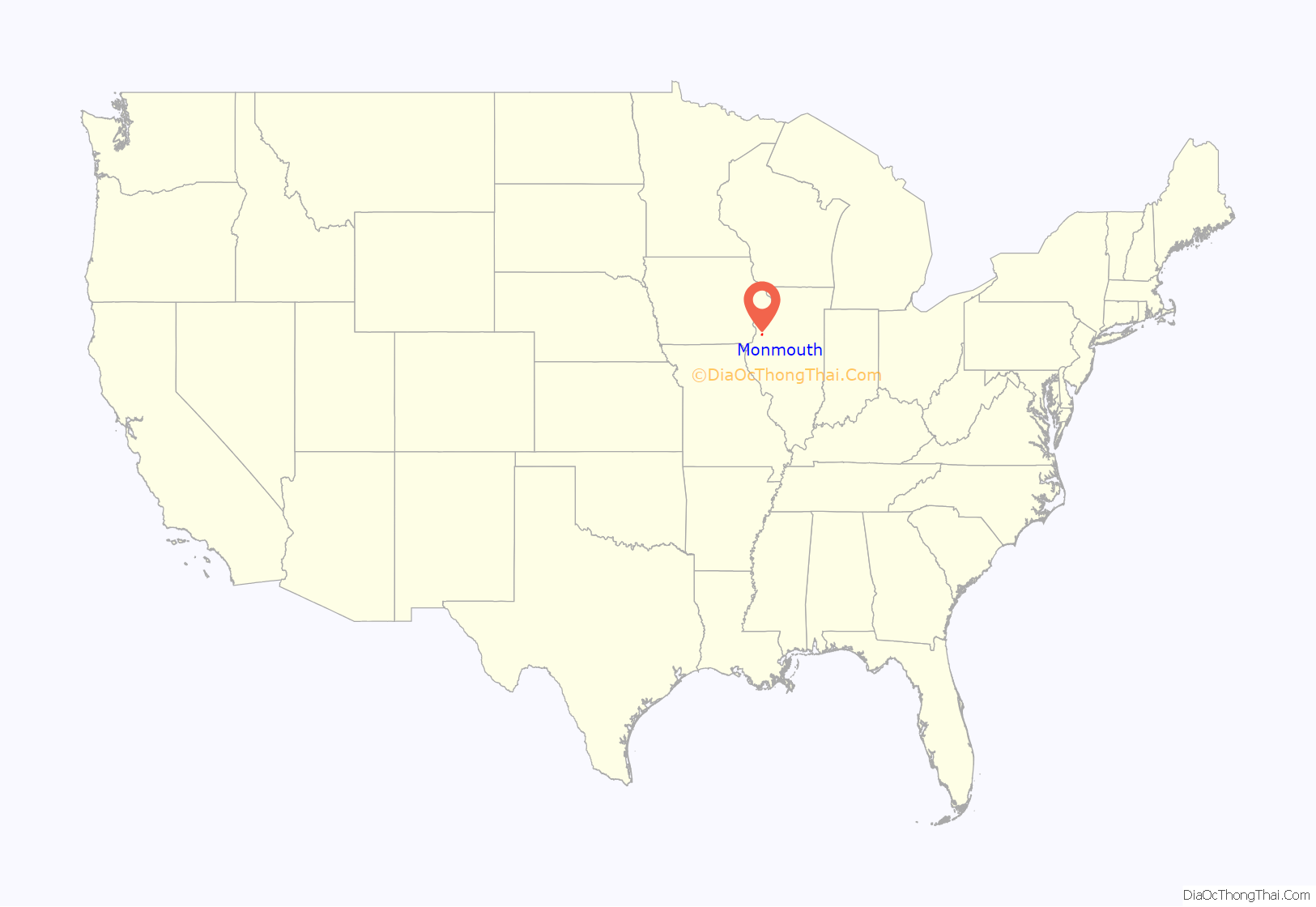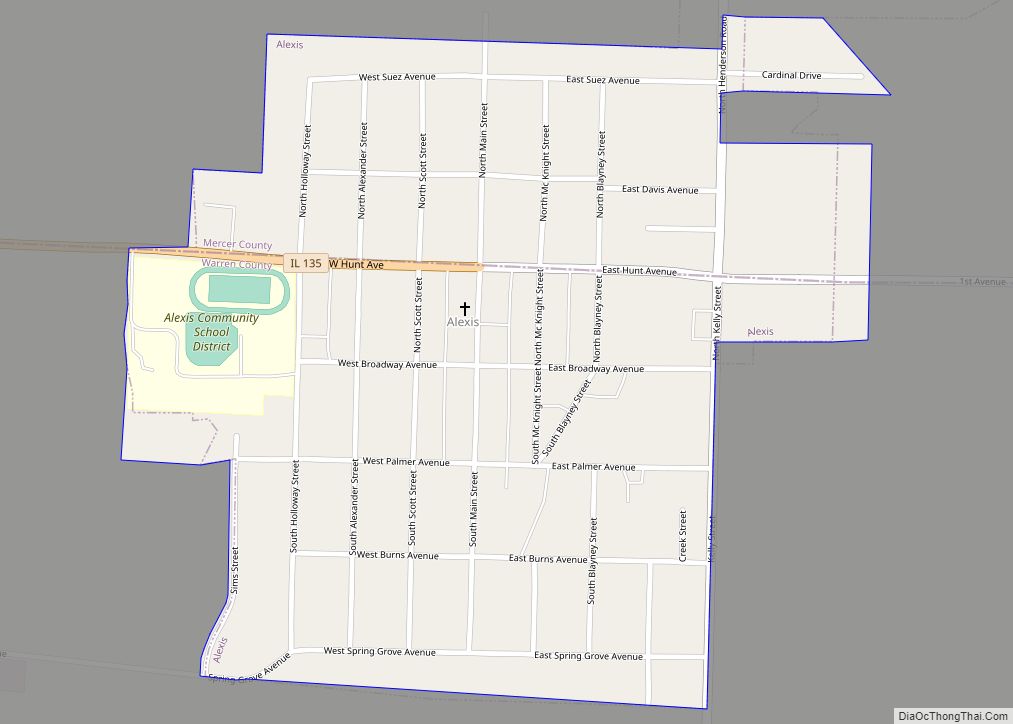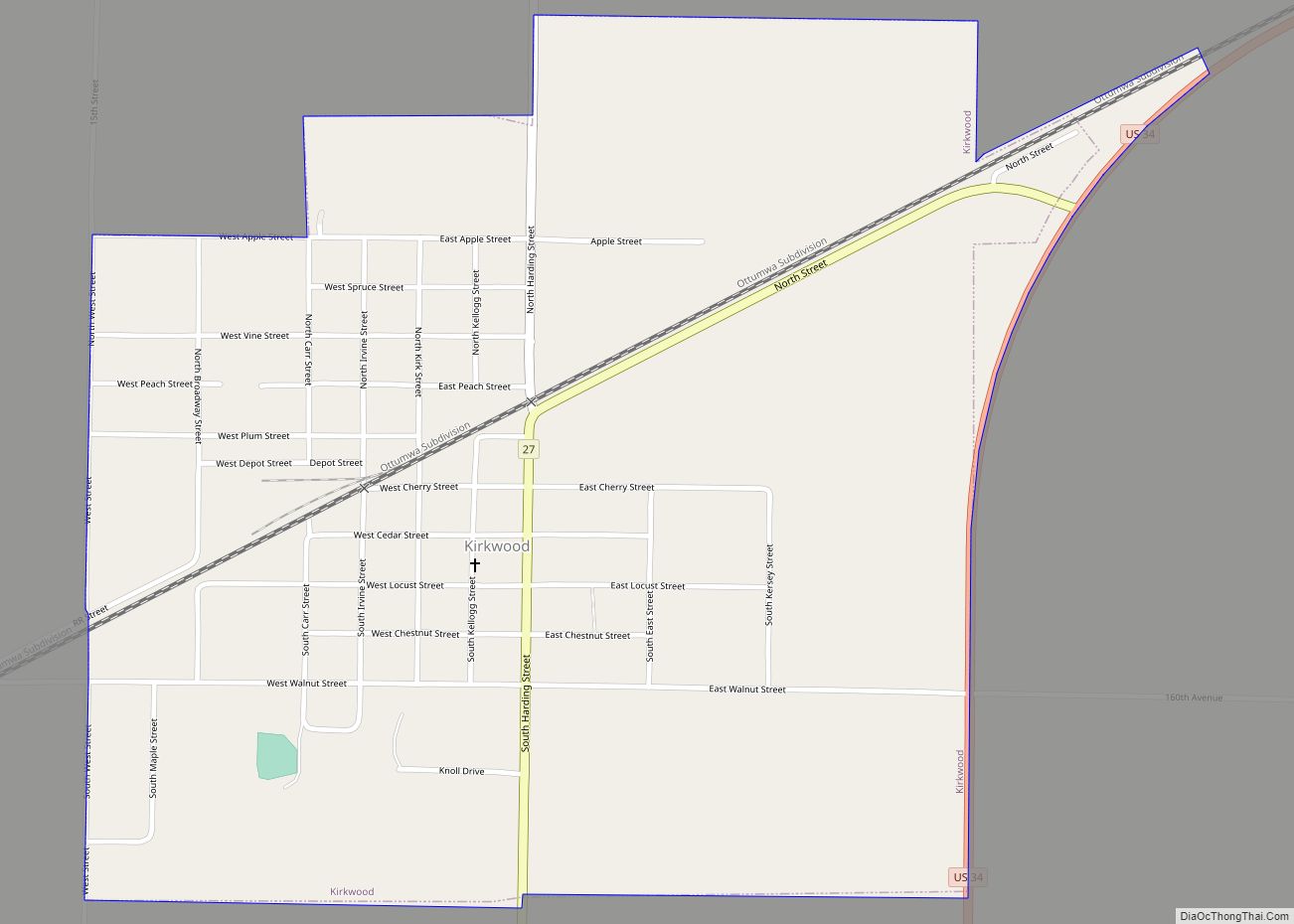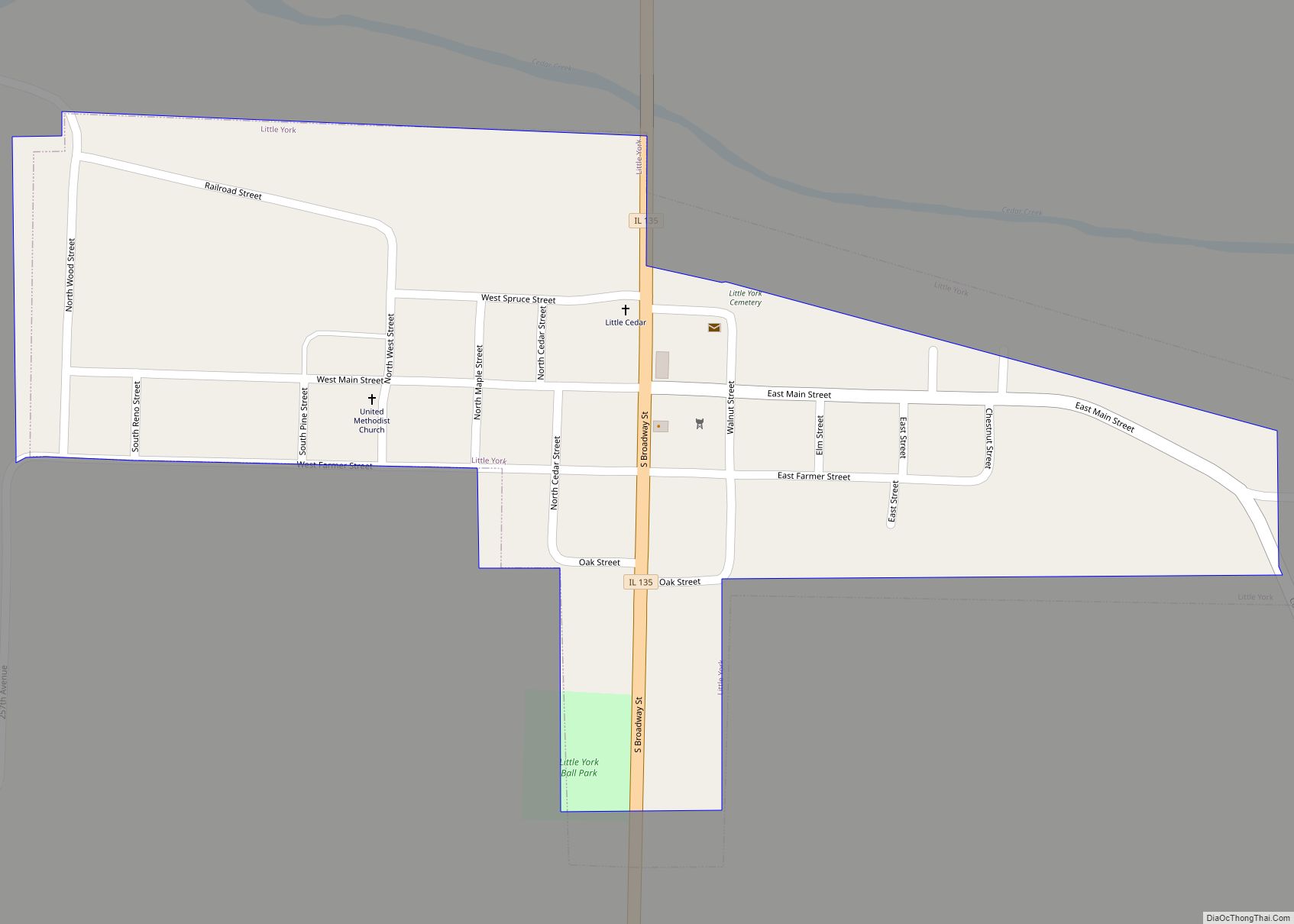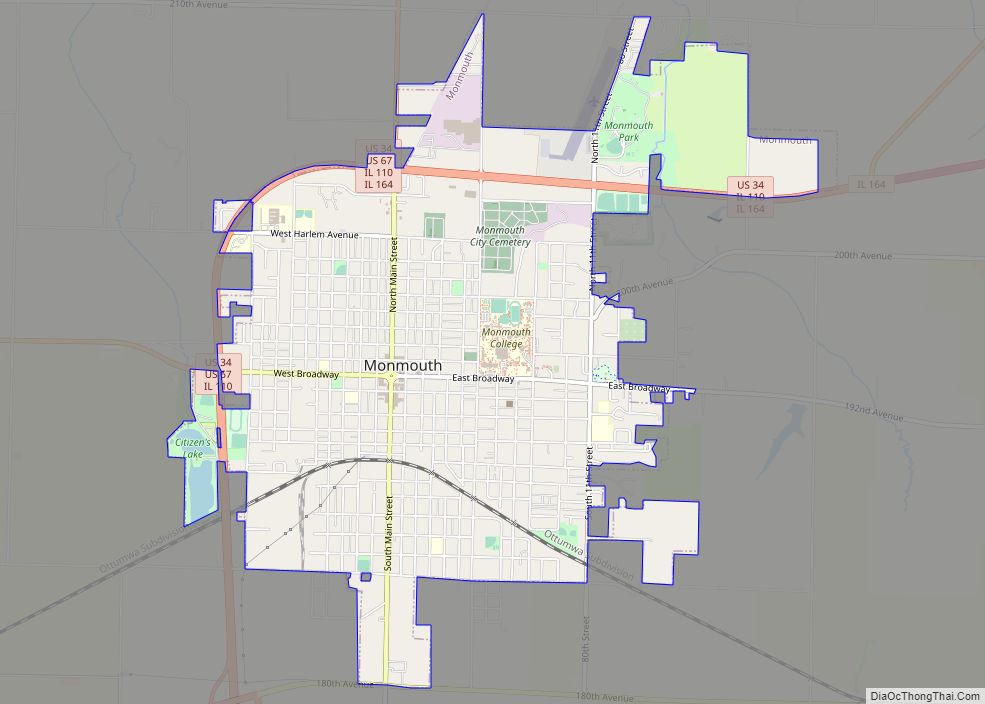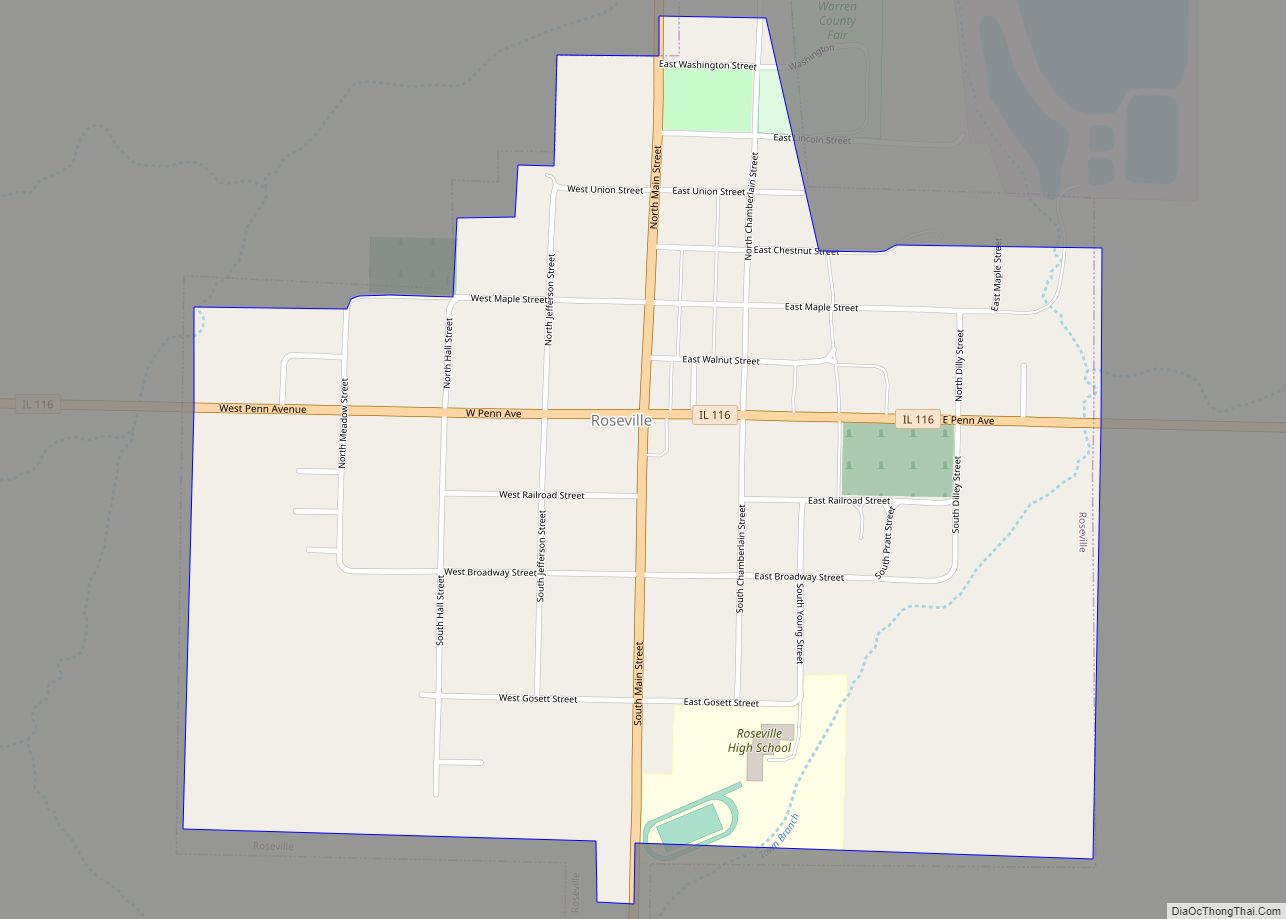Monmouth is a city in and the county seat of Warren County, Illinois, United States. The population was 8,902 at the 2020 census, down from 9,444 in 2010. It is the home of Monmouth College and contains Monmouth Park, Harmon Park, North Park, Warfield Park, West Park, South Park, Garwood Park, Buster White Park and the Citizens Lake & Campground. It is the host of the Prime Beef festival, held annually the week after Labor Day. The festival is kicked off with one of the largest parades in Western Illinois. Monmouth is also known regionally as the “Maple City”. It is part of the Galesburg Micropolitan Statistical Area.
| Name: | Monmouth city |
|---|---|
| LSAD Code: | 25 |
| LSAD Description: | city (suffix) |
| State: | Illinois |
| County: | Warren County |
| Elevation: | 751 ft (229 m) |
| Total Area: | 4.26 sq mi (11.04 km²) |
| Land Area: | 4.24 sq mi (10.99 km²) |
| Water Area: | 0.02 sq mi (0.05 km²) |
| Total Population: | 8,902 |
| Population Density: | 2,098.54/sq mi (810.31/km²) |
| Area code: | 309 |
| FIPS code: | 1750010 |
| GNISfeature ID: | 2395371 |
| Website: | cityofmonmouth.com |
Online Interactive Map
Click on ![]() to view map in "full screen" mode.
to view map in "full screen" mode.
Monmouth location map. Where is Monmouth city?
History
The town established in 1831 was originally going to be called Kosciusko (the name was drawn out of a hat), but the founders of the town feared that it would be difficult to spell and pronounce. The name ‘Monmouth’ was put forward by a resident who had lived in Monmouth County, New Jersey.
In 1841, Latter Day Saint movement founder Joseph Smith appeared before Judge Stephen A. Douglas in an extradition hearing held at Monmouth’s Warren County courthouse. The hearing, which was to determine whether Smith should be returned to Missouri to face murder charges, resulted in freedom for the defendant, as it was determined that his arrest had been invalid. Attorney Orville Browning, who would assume Douglas’s Senate seat following his death, represented Smith.
Gunfighter Wyatt Earp was born in Monmouth. For many years, the town watertower boasted that Monmouth was the “Home of Wyatt Earp.” Controversial Civil War general Eleazer A. Paine practiced law there for many years. Abner C. Harding, Civil War General and Republican Congressman, lived in Monmouth and is buried in Monmouth Cemetery. Ronald Reagan lived in Monmouth for a while as a child when his father worked as a shoe salesman at the Colwell Department Store and mass murderer Richard Speck lived in Monmouth briefly as a child, and again in the spring of 1966.
Monmouth College, a private liberal arts college affiliated with the Presbyterian Church (U.S.A.), was founded in Monmouth in 1853 by Cedar Creek & South Henderson Presbyterian Churches. With James Cochran Porter & Robert Ross Founding in 1852 Monmouth Academy. The Rev. David Alexander Wallace serving as the first President 1856–1878. It is the second-largest employer in the city. Pi Beta Phi, the first national secret college society of women to be modeled after the Greek-letter fraternities of men, was founded on its campus in 1867. Just three years later in 1870, Kappa Kappa Gamma, international fraternity for women, was founded on its campus.
Monmouth was home to minor league baseball from 1890 to 1913. The Monmouth Browns and Monmouth Maple Cities (1890) played as members of the Central Association (1910–1913), Illinois-Missouri League (1908–1909), Central Interstate League (1889) and Illinois-Iowa League (1890). Monmouth teams played at 11th Street Park.
Monmouth was once home to one of the most unusually named high school sports organizations, the Zippers. Originally known as The Maroons, the Zipper nickname came about in the late 1930s when the school had a fast basketball team that would “Zip” up and down the court. Earl Bennett, a sportswriter nicknamed them “The Zippers” and the name stuck. The school went with the “Zipper” nickname until the 2004–05 school year when Monmouth consolidated with Roseville and the new Monmouth-Roseville High School adopted the nickname “The Titans”. The class of 2005 was the last class named the Zippers. The Class of 2006 was the first class named the Titans.
Monmouth was the home for Western Stoneware, known for its “Maple Leaf” imprint and for producing “Sleepy Eye” collectible ceramics, which are recognizable by the blue-on-white bas-relief Indian profile. Western Stoneware closed in June 2006. Three former employees of Western Stoneware now operate the facility under the name “WS”, Inc and have leased the building and logo from the city of Monmouth.
Monmouth Road Map
Monmouth city Satellite Map
Geography
Monmouth is located in Western Illinois where US Route 34, US Route 67, Illinois Route 164, and now the new Chicago to Kansas City Expressway (Illinois Route 110) intersect.
According to the 2010 census, Monmouth has a total area of 4.231 square miles (10.96 km), of which 4.21 square miles (10.90 km) (or 99.5%) is land and 0.021 square miles (0.05 km) (or 0.5%) is water.
Climate
See also
Map of Illinois State and its subdivision:- Adams
- Alexander
- Bond
- Boone
- Brown
- Bureau
- Calhoun
- Carroll
- Cass
- Champaign
- Christian
- Clark
- Clay
- Clinton
- Coles
- Cook
- Crawford
- Cumberland
- De Kalb
- De Witt
- Douglas
- Dupage
- Edgar
- Edwards
- Effingham
- Fayette
- Ford
- Franklin
- Fulton
- Gallatin
- Greene
- Grundy
- Hamilton
- Hancock
- Hardin
- Henderson
- Henry
- Iroquois
- Jackson
- Jasper
- Jefferson
- Jersey
- Jo Daviess
- Johnson
- Kane
- Kankakee
- Kendall
- Knox
- La Salle
- Lake
- Lake Michigan
- Lawrence
- Lee
- Livingston
- Logan
- Macon
- Macoupin
- Madison
- Marion
- Marshall
- Mason
- Massac
- McDonough
- McHenry
- McLean
- Menard
- Mercer
- Monroe
- Montgomery
- Morgan
- Moultrie
- Ogle
- Peoria
- Perry
- Piatt
- Pike
- Pope
- Pulaski
- Putnam
- Randolph
- Richland
- Rock Island
- Saint Clair
- Saline
- Sangamon
- Schuyler
- Scott
- Shelby
- Stark
- Stephenson
- Tazewell
- Union
- Vermilion
- Wabash
- Warren
- Washington
- Wayne
- White
- Whiteside
- Will
- Williamson
- Winnebago
- Woodford
- Alabama
- Alaska
- Arizona
- Arkansas
- California
- Colorado
- Connecticut
- Delaware
- District of Columbia
- Florida
- Georgia
- Hawaii
- Idaho
- Illinois
- Indiana
- Iowa
- Kansas
- Kentucky
- Louisiana
- Maine
- Maryland
- Massachusetts
- Michigan
- Minnesota
- Mississippi
- Missouri
- Montana
- Nebraska
- Nevada
- New Hampshire
- New Jersey
- New Mexico
- New York
- North Carolina
- North Dakota
- Ohio
- Oklahoma
- Oregon
- Pennsylvania
- Rhode Island
- South Carolina
- South Dakota
- Tennessee
- Texas
- Utah
- Vermont
- Virginia
- Washington
- West Virginia
- Wisconsin
- Wyoming
